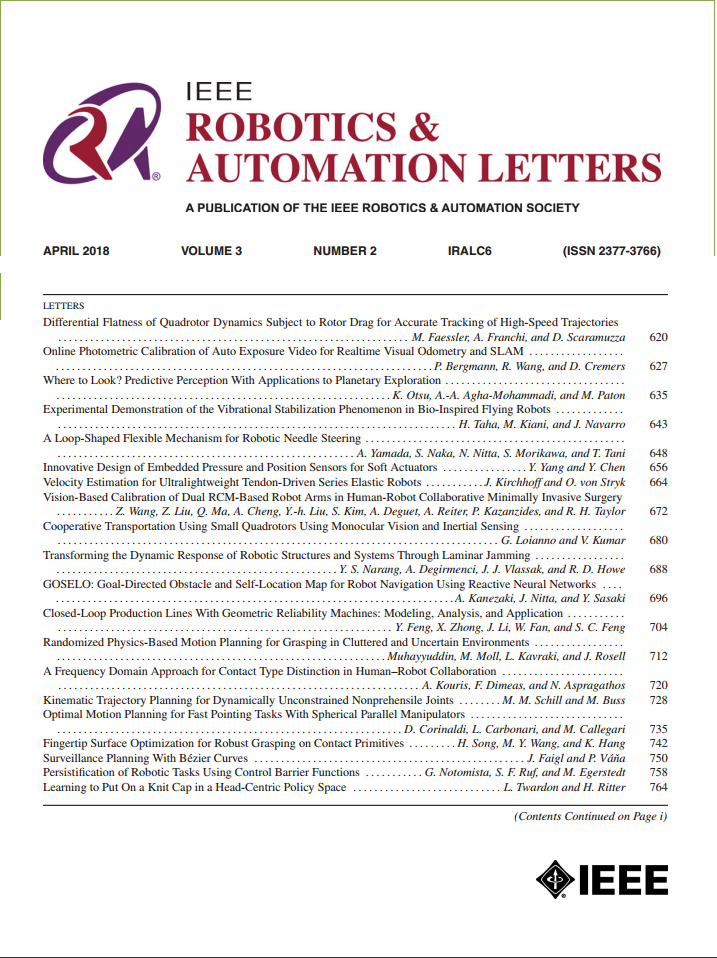基于无气味卡尔曼滤波的物理信息神经网络在人形机器人无传感器关节力矩估计中的应用
IF 4.6
2区 计算机科学
Q2 ROBOTICS
引用次数: 0
摘要
本文提出了一种新的无关节扭矩传感器的仿人机器人全身扭矩控制框架,该框架适用于电动机和高比率谐波驱动系统。该方法在实时扭矩控制架构中集成了用于摩擦建模的物理信息神经网络(pinn)和用于关节扭矩估计的Unscented卡尔曼滤波(UKF)。pinn从关节和电机速度读数中估计非线性静态和动态摩擦,捕获无关节运动的电机驱动等效应。UKF利用基于pup的摩擦估计作为直接测量输入,提高了扭矩估计的鲁棒性。通过动平衡实验,ergoCub人形机器人的实验验证表明,与最先进的递归牛顿-欧拉算法(RNEA)相比,ergoCub机器人的扭矩跟踪精度更高,能效更高,抗干扰能力更强。该框架的可扩展性体现在具有相似硬件但不同摩擦特性的机器人之间的一致性能,而无需重新识别。此外,通过与位置控制的比较分析,突出了所提出的转矩控制方法的优点。结果表明,该方法是一种可扩展和实用的解决方案,用于人形机器人的无传感器扭矩控制,确保扭矩跟踪,适应性和稳定性在动态环境中。本文章由计算机程序翻译,如有差异,请以英文原文为准。
Physics-Informed Neural Networks With Unscented Kalman Filter for Sensorless Joint Torque Estimation in Humanoid Robots
This paper presents a novel framework for whole-body torque control of humanoid robots without joint torque sensors, designed for systems with electric motors and high-ratio harmonic drives. The approach integrates Physics-Informed Neural Networks (PINNs) for friction modeling and Unscented Kalman Filtering (UKF) for joint torque estimation, within a real-time torque control architecture. PINNs estimate nonlinear static and dynamic friction from joint and motor velocity readings, capturing effects like motor actuation without joint movement. The UKF utilizes PINN-based friction estimates as direct measurement inputs, improving torque estimation robustness. Experimental validation on the ergoCub humanoid robot demonstrates improved torque tracking accuracy, enhanced energy efficiency, and superior disturbance rejection compared to the state-of-the-art Recursive Newton-Euler Algorithm (RNEA), using a dynamic balancing experiment. The framework's scalability is shown by consistent performance across robots with similar hardware but different friction characteristics, without re-identification. Furthermore, a comparative analysis with position control highlights the advantages of the proposed torque control approach. The results establish the method as a scalable and practical solution for sensorless torque control in humanoid robots, ensuring torque tracking, adaptability, and stability in dynamic environments.
求助全文
通过发布文献求助,成功后即可免费获取论文全文。
去求助
来源期刊

IEEE Robotics and Automation Letters
Computer Science-Computer Science Applications
CiteScore
9.60
自引率
15.40%
发文量
1428
期刊介绍:
The scope of this journal is to publish peer-reviewed articles that provide a timely and concise account of innovative research ideas and application results, reporting significant theoretical findings and application case studies in areas of robotics and automation.
 求助内容:
求助内容: 应助结果提醒方式:
应助结果提醒方式:


